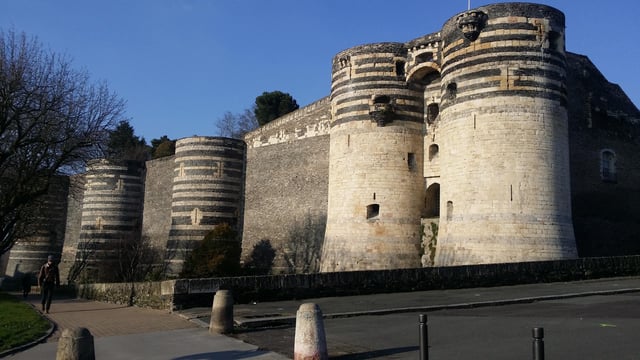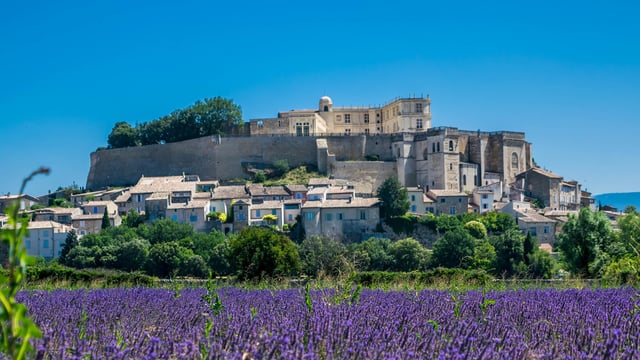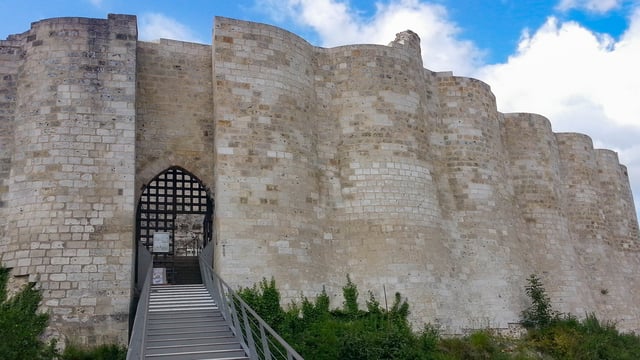Fortifications, Castles & Palaces in France

Castles & Palaces in & Near Paris

Châteaux of the Loire Valley

Cathar Castles

Castles of the Neustria Marches
Must-See Palaces in France
Palais des Papes
For most of the 14th century Avignon was the seat of Western Christianity. The Palais des Papes is in fact two conjoining Papal palaces: the Palais Vieux and Palais Neuf. Together they make up the largest Gothic building in Europe, and one of the most important. The Episcopal complex, the 12th century bridge and the historic centre of Avignon were added to the UNESCO list of World Heritage Sites in 1995.

Palace of Fontainebleau
What started as a medieval castle developed into one of the largest royal and imperial palaces in France. This is where French monarchs from Louis VII to Napoleon III lived. In the early 12th century fortified castle was a favourite royal hunting lodge, given the game in the surrounding forest. In the early 16th century the Renaissance palace was built for Francis I, and succeeding kings and emperors each made their own mark. The palace is only 55km from Paris and is easy to get to on public transport, making this a very popular day trip from Paris.

Palais du Louvre - Louvre Museum
Now one of the most famous museums in the world, the Louvre was a Royal residence. A 12 century fortress became a residence for Charles V in the mid 14th century, when he abandoned the Palais de la Cité. Since then it the principle residence of kings of France until the French Revolution, when parts of it became a public museum. The museum now occupies the entire complex. Collections include art and antiquities from France and Mediterranean Europe (Etruscan, Greek and Roman). There are also substantial collections of Egyptian and Near Eastern antiquities, from late prehistory to the start of Christian and Islamic periods.

Palace of Versailles
Originally a 17th century hunting lodge built for Louis XIII, the palace was transformed into a symbol of royal power and opulence by Louis XIV. Following the French Revolution, the palace was opened to tours and a small museum created in 1793. By the 19th century the palace became a tourist attraction. On 28 June 1919 the most important treaty of WWI was signed in the Hall of Mirrors. Today visitors are able to explore the ornate halls and luxurious Royal apartments, as well as the immaculately landscaped gardens. Also accessible are the Trianon Palaces and Marie-Antoinette’s Hamlet.

Palace of Compiègne
Charles V had the first castle built here, which was nearly complete on his death in 1380. It was a favourite summer retreat with a number of succeeding kings of France. But the Neoclassical castle we see today owes much to Louis XV who liked to hunt in the adjacent forest. His grandson, Louis XVI, had new wings added. Following the French revolution the furniture and art was sold, and the castle became the home of a military academy until Napoleon I chose to live here. Napoleon had the castle substantially refurbished, some of the décor and furnishings can still be seen today. Open to the public are the grandest imperial apartments of the First Empire. The palace also houses the National Car Museum.

Must-See Castles in France
Château d'Angers
A Neolithic tomb is the earliest evidence for human occupation of what is today the site of a spectacular medieval fortress. It is the 13th century 17 towers placed at intervals in the 500 metre-long ramparts that catch your attention. During the 14th and 15th centuries the Dukes of Anjou held court here, and built the elaborate castle, gardens and a chapel. A highlight is the 14th century Apocalypse Tapestry, originally 140 m, 100 m of which is on display. Just one in what is the world’s largest collection of medieval tapestries.

Château d'Azay-le-Rideau
The picturesque island-like setting of the Château d’Azay-le-Rideau on the Indre River makes this one of the most popular castles of the Loire Valley. Built in the early 16th century, it is now widely recognised as one of the finest examples of early French Renaissance architecture. The style of both the exterior and the interior show a striking influence in the then fashionable Italian Renaissance. In 1905 the castle was purchased by the state, and in 1939/40 it housed the Ministry of Education when the French government left Paris.

Château de Beynac
Said to be the best preserved castle in the Perigord region, Château de Beynac is certainly one of the more picturesque. Hence why it has been used as a location for a number of films, including Luc Besson’s 1999 Jeanne d’Arc. Visitors get an excellent audio guide that follows an interesting route through the various architectural and historical features of the castle, including 15th century frescoes and the crenellated Romanesque terrace. During the 100 Year’s War the castle was on the side of the French.

Château de Grignan
On a rocky outcrop overlooking the village of Grignan is the largest Renaissance castle in southeastern France. An 11th century fortress was transformed into a sumptuous Renaissance palace by the Adhémar family in the 7th century. The Marquise of Sévigné, whose letters to her daughter made her a historical writer of note, lived and died here. The castle was destroyed during the Revolution, but reconstructed in the 20th century. During the lavender season, there are spectacular views from the castle, and of the castle.

Château de Maintenon
Construction of the castle began sometime in the 12th century. But the Château de Maintenon is better known as the private residence of Madame de Maintenon, Louis XIV’s his second wife. In 1675 the king purchased the castle for his then mistress Madame de Maintenon, and had staff from Versailles renovate the building and gardens. It is said Madame de Maintenon loved the castle’s beauty and solitude. A tour of the castle takes in both the 17th century and 19th century apartments, a walk in the French gardens leading to the ruins of the unfinished aqueduct, intended to supply water to the fountains of Versailles.

Château de Montsoreau
Chateau de Montsoreau is one of the earlier castles in the Loire Valley, marking the transition from a strategic military fort to an opulent residence. The existing castle, built in the 1450s, was built on the ruins of an earlier fort and has featured prominently in the arts, from a novel by Alexander Dumas to a watercolour by William Turner. Besides an exhibition on the castle’s history, the castle is a museum of contemporary art, with Philippe Méaille’s collection of conceptual art.

Château Fort de Rambures
Passed down through marriage and inheritance, the Rambures estate has been in the same family since the 11th century, although the castle was completed after the 100 Year’s War in the 15th century. Built largely of brick, the square castle with four towers lies within a dry moat. Lord Rambures is mentioned in William Shakespeare’s play Henry V. The castle is set in a romantic park with an 18th century chapel, an English style park with a historic collection of roses.

Château Gaillard
A ruined medieval fortress, or château-fort, located high above the town of Le Andelys and overlooking the Seine River. The castle was built for Richard the Lionheart, who was then both King of England and the feudal Duke of Normandy. Construction began in 1196 and was completed within two years. Advanced features common in many later castles were used here. Gaillard, for example, has one of the earliest uses concentric fortifications and one of the first uses of machicolations in the defensive walls

Must-See Medieval Walled Towns & Cities in France
Aigues-Mortes
This part of the swampy Camargue has been exploited for the salt since Neolithic times. Charlemagne was the first to have a tower erected, in 791 AD to help the fishermen and salt workers. Later in the 13th century Louis IX developed the town’s defences so that France was not dependent on Italy for her involvement in the Crusades. Twice, for the 7th and 8th Crusades, Louis IX left for the Levant from here. But it was not until the very beginning of the 14th century, after some 30 years after Louis’s death that the walls completely encircled the city.

Laon - the Crowned Mountain
Laon is full of beauty, its churches, its houses, its surroundings, everything. These are the words of Victor Hugo to his wife in 1835. At the centre of the city is a hilltop, which attracted Stone Age communities as well as the Romans. Today a spectacular Gothic cathedral with four towers sites at the top, hence the name the ‘Crowned Mountain’. Home to the early Frankish kings Clovis and Hugues Capet, there is still much of the medieval town to see, including the 9th century and later fortifications, numerous churches and abbeys, the Episcopal Palace and a Templars Chapel.

Medieval Carcassonne - La Cité
The medieval fortified city of Carcassonne, known locally as la Cité, is one of the most popular destination for visitors to the south of France. The citadel has been occupied since prehistoric times, but it was the Romans who first built a series of walls, parts of which can still be seen. These were added to by the Visigoths, Crusaders and other. As spectacular as the imposing walls are, much of what we see today is the result of 19th century restorations, which are not accurate. But well worth a visit, even with the tourists, for the Roman and Medieval ramparts, the Basilica of Saints Nazarius and Celsus, and the medieval castle & museum.

Mont Saint-Michel
Mont Saint Michel is one of the most popular attractions outside of Paris. Many think it is a castle. Mont Saint Michel is not a castle. Rather, it is tidal island on which one of the most spectacular medieval abbeys was built on a conical rock, hence why is its called <em>La Merveille</em> (the wonder). A village developed around the abbey and as the island has immense strategic importance it was heavily fortified in the 14th century against attack from the English during the 100 Years War. The substantial ramparts held off English assaults.


Provins - Town of Medieval Fairs
The fortified town of Provins is well known for its medieval architecture, in particular the well preserved 12th century city walls. For the Romans, Provins was at the crossroads of two major roads in Roman Gaul. The towns importance and prosperity continue to grow. By the 9th century AD Provins produced its own coins. The strategic position made it one of the most important fair towns in medieval Europe from the 12th century, in trade across Europe generally and in the wool industry specifically. Harsh taxation in the 14th century meant the town suffered. But being largely unaffected by the Industrial Revolution save its medieval character. Provins is a popular day trip from Paris.





















